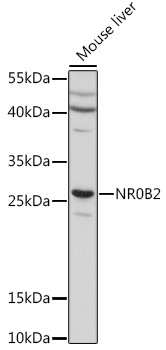Cell Biology Antibodies 7
Anti-NR0B2 Antibody (CAB16454)
- SKU:
- CAB16454
- Product Type:
- Antibody
- Reactivity:
- Human
- Reactivity:
- Mouse
- Host Species:
- Rabbit
- Isotype:
- IgG
- Antibody Type:
- Polyclonal Antibody
- Research Area:
- Cell Biology
Description
| Antibody Name: | Anti-NR0B2 Antibody |
| Antibody SKU: | CAB16454 |
| Antibody Size: | 20uL, 50uL, 100uL |
| Application: | WB |
| Reactivity: | Human, Mouse |
| Host Species: | Rabbit |
| Immunogen: | Recombinant fusion protein containing a sequence corresponding to amino acids 1-257 of human NR0B2 (NP_068804.1). |
| Application: | WB |
| Recommended Dilution: | WB 1:500 - 1:2000 |
| Reactivity: | Human, Mouse |
| Positive Samples: | Mouse liver |
| Immunogen: | Recombinant fusion protein containing a sequence corresponding to amino acids 1-257 of human NR0B2 (NP_068804.1). |
| Purification Method: | Affinity purification |
| Storage Buffer: | Store at -20'C. Avoid freeze / thaw cycles. Buffer: PBS with 0.02% sodium azide, 50% glycerol, pH7.3. |
| Isotype: | IgG |
| Sequence: | MSTS QPGA CPCQ GAAS RPAI LYAL LSSS LKAV PRPR SRCL CRQH RPVQ LCAP HRTC REAL DVLA KTVA FLRN LPSF WQLP PQDQ RRLL QGCW GPLF LLGL AQDA VTFE VAEA PVPS ILKK ILLE EPSS SGGS GQLP DRPQ PSLA AVQW LQCC LESF WSLE LSPK EYAC LKGT ILFN PDVP GLQA ASHI GHLQ QEAH WVLC EVLE PWCP AAQG RLTR VLLT ASTL KSIP TSLL GDLF FRPI IGDV DIAG LLGD MLLL R |
| Gene ID: | 8431 |
| Uniprot: | Q15466 |
| Cellular Location: | Cytoplasm, Nucleus |
| Calculated MW: | 28kDa |
| Observed MW: | 28kDa |
| Synonyms: | NR0B2, SHP, SHP1 |
| Background: | The protein encoded by this gene is an unusual orphan receptor that contains a putative ligand-binding domain but lacks a conventional DNA-binding domain. The gene product is a member of the nuclear hormone receptor family, a group of transcription factors regulated by small hydrophobic hormones, a subset of which do not have known ligands and are referred to as orphan nuclear receptors. The protein has been shown to interact with retinoid and thyroid hormone receptors, inhibiting their ligand-dependent transcriptional activation. In addition, interaction with estrogen receptors has been demonstrated, leading to inhibition of function. Studies suggest that the protein represses nuclear hormone receptor-mediated transactivation via two separate steps: competition with coactivators and the direct effects of its transcriptional repressor function. |
| UniProt Protein Function: | NR0B2: Acts as a transcriptional regulator. Acts as a negative regulator of receptor-dependent signaling pathways. Specifically inhibits transactivation of the nuclear receptor with whom it interacts. Inhibits transcriptional activity of NEUROD1 on E-box- containing promoter by interfering with the coactivation function of the p300/CBP-mediated trancription complex for NEUROD1. Defects in NR0B2 may be associated with obesity (OBESITY). It is a condition characterized by an increase of body weight beyond the limitation of skeletal and physical requirements, as the result of excessive accumulation of body fat. Belongs to the nuclear hormone receptor family. NR0 subfamily. |
| UniProt Protein Details: | Protein type:Nuclear receptor co-regulator; Nuclear receptor; Transcription, coactivator/corepressor Chromosomal Location of Human Ortholog: 1p36.1 Cellular Component: nucleoplasm; protein complex; cytoplasm; nucleus Molecular Function:retinoid X receptor binding; protein domain specific binding; protein binding; peroxisome proliferator activated receptor binding; protein homodimerization activity; DNA binding; protein complex binding; steroid hormone receptor activity; thyroid hormone receptor binding; transcription factor activity; transcription corepressor activity Biological Process: cholesterol metabolic process; transcription initiation from RNA polymerase II promoter; organ regeneration; negative regulation of transcription factor activity; response to glucose stimulus; positive regulation of insulin secretion; steroid hormone mediated signaling; gene expression; negative regulation of transcription from RNA polymerase II promoter Disease: Obesity |
| NCBI Summary: | The protein encoded by this gene is an unusual orphan receptor that contains a putative ligand-binding domain but lacks a conventional DNA-binding domain. The gene product is a member of the nuclear hormone receptor family, a group of transcription factors regulated by small hydrophobic hormones, a subset of which do not have known ligands and are referred to as orphan nuclear receptors. The protein has been shown to interact with retinoid and thyroid hormone receptors, inhibiting their ligand-dependent transcriptional activation. In addition, interaction with estrogen receptors has been demonstrated, leading to inhibition of function. Studies suggest that the protein represses nuclear hormone receptor-mediated transactivation via two separate steps: competition with coactivators and the direct effects of its transcriptional repressor function. [provided by RefSeq, Jul 2008] |
| UniProt Code: | Q15466 |
| NCBI GenInfo Identifier: | 9978744 |
| NCBI Gene ID: | 8431 |
| NCBI Accession: | Q15466.2 |
| UniProt Secondary Accession: | Q15466,Q5QP36, F1D8P5, |
| UniProt Related Accession: | Q15466 |
| Molecular Weight: | |
| NCBI Full Name: | Nuclear receptor subfamily 0 group B member 2 |
| NCBI Synonym Full Names: | nuclear receptor subfamily 0, group B, member 2 |
| NCBI Official Symbol: | NR0B2 |
| NCBI Official Synonym Symbols: | SHP; SHP1 |
| NCBI Protein Information: | nuclear receptor subfamily 0 group B member 2; nuclear receptor SHP; small heterodimer partner; orphan nuclear receptor SHP |
| UniProt Protein Name: | Nuclear receptor subfamily 0 group B member 2 |
| UniProt Synonym Protein Names: | Orphan nuclear receptor SHP; Small heterodimer partner |
| Protein Family: | Nuclear receptor subfamily |
| UniProt Gene Name: | NR0B2 |
| UniProt Entry Name: | NR0B2_HUMAN |







